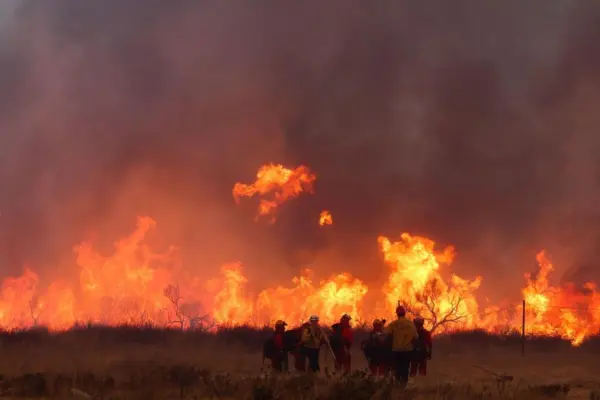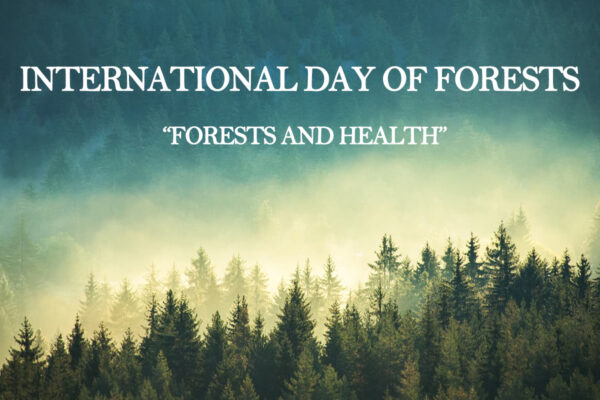Catastrophic Australian Bushfires Ravaging the Island Continent
Bushfires are an annual occurrence in Australia and the continent has always experienced wildfires. Apparently, Australia has a ‘fire season’ for crying out loud as every summer season (which is marked from December to February), the episodes of wildfires are very common.
But the drought conditions and unprecedented heat, which the country experienced throughout the last year, have intensified the fire in this bushfire season. People have been sharing the heart-wrenching pictures and videos of this catastrophe on social media.
The fires in Australia are devastating – and the crisis is still ongoing.
More than 5 million hectares have been burnt, and this number continues to climb – that’s the equivalent of one fifth of the entire UK. #AustraliaBushfires pic.twitter.com/jh9ZWQWQei
— WWF-UK (@wwf_uk) January 3, 2020
Fires across Australia have burned more than 10 million hectares, marking one of the country’s worst bushfire seasons on record. Raging fires have destroyed thousands of homes, killed many people, and taken the lives of millions of wild animals, and burned down 80% of the Blue Mountains, and 50% of the Gondwana world heritage rainforests.
Table of Contents
Origin of the Bushfires
✦ Although the fires have started since July 1, 2019, the first deadly fire sparked up in mid-November in the Snowy Valley, just a few kilometers to the northern side of the Victorian border.
✦ Several fires broke out around rural Victoria, both in the north-west and near the coast, but most attention was focused on catastrophic fires that were ripping through the Blue Mountains, the Hawkesbury, and parts of northern New South Wales (NSW).
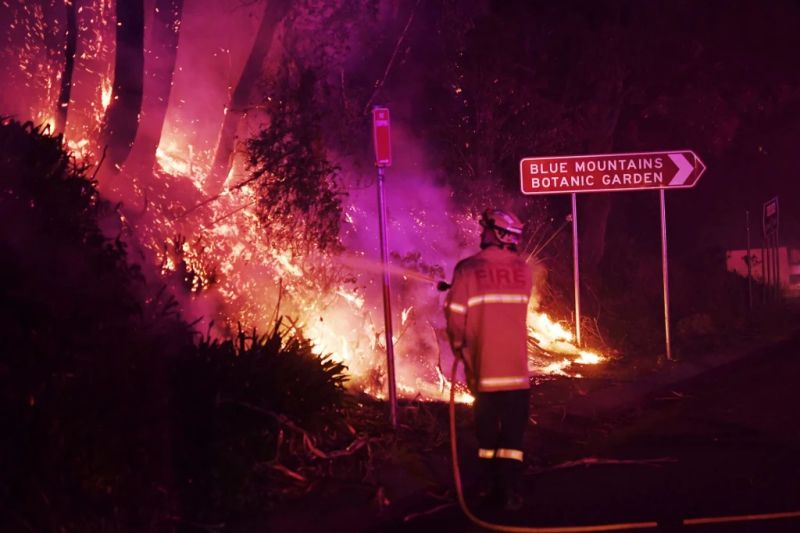
Bushfires burning through the Blue Mountains in Australia / Image: The Sydney Morning Herald
✦ In particular, the Gospers Mountain fire, which broke out from a single ignition point in October and became the biggest forest fire that Australia has ever seen, received much attention and gobbled up resources.
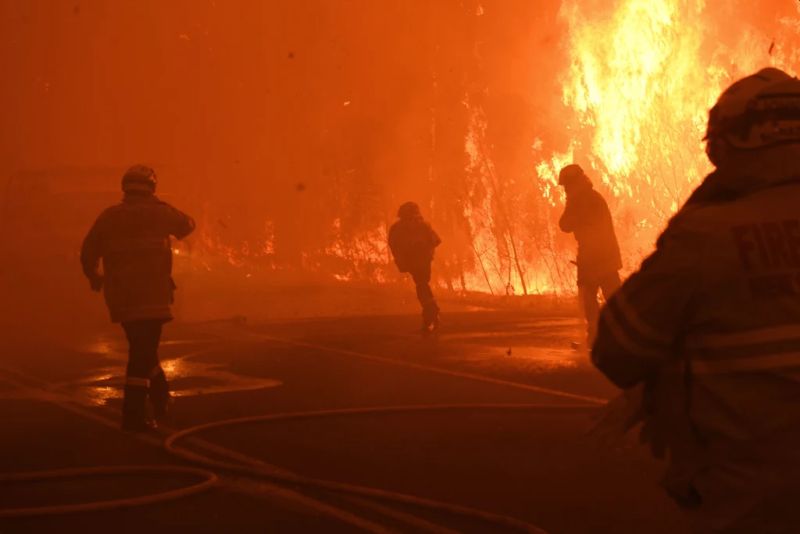
Gospers Mountain fire in October / Image: The Sydney Morning Herald
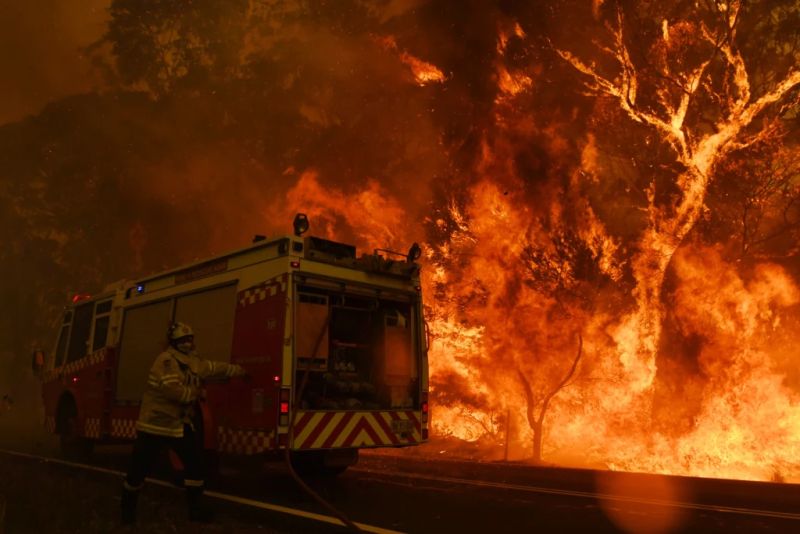
Biggest bushfire Australia has ever seen / Image: The Sydney Morning Herald
✦ Towards the end of the month, the bushfires severely damaged the Currowan State Forest, north of Batemans Bay.
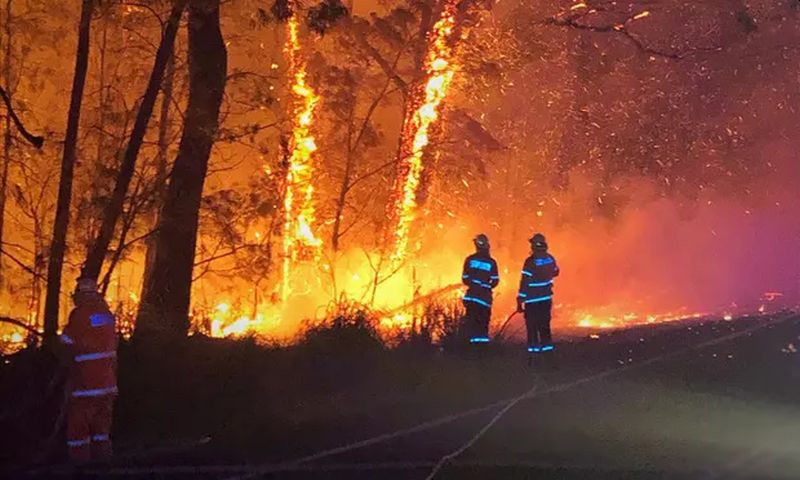
Firefighters tackling the Currowan bushfire / Image: The Guardian
✦ The fires grew to the size of 11,000 hectares area within a week and reached more than 300,000 hectares within a month.
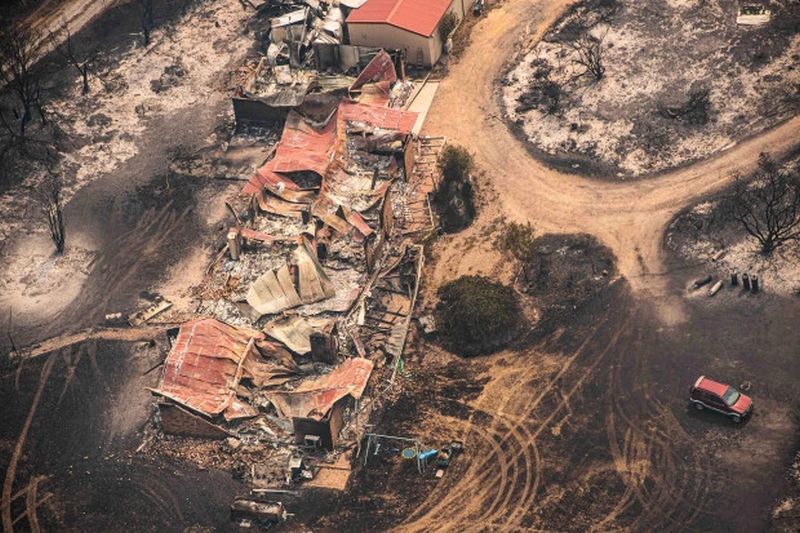
Homes destroyed in a fire in Batemans Bay / Image: The Sun
Blazes in Early December
✦ In early December, Sydney’s air quality deteriorated to a poor level. On the south-west fringe of Sydney, the Green Wittle Creek fire savored towns and bushland, south-west of the city homes and lives were tragically lost.
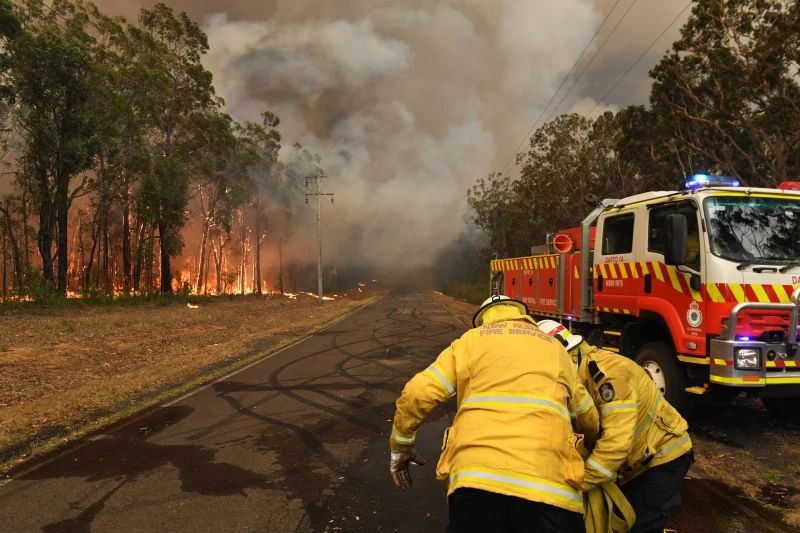
Green Wittle Creek fire on outskirts of Sydney / Image: The Sydney Morning Herald
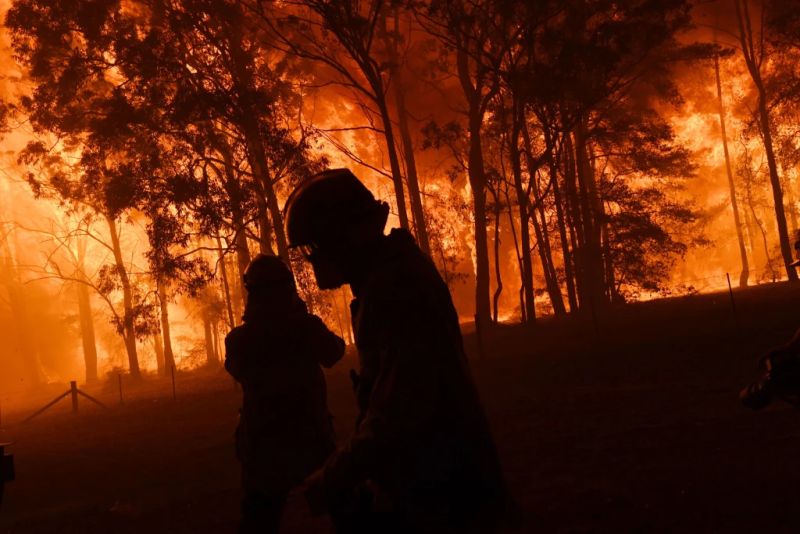
The raging fire engulfed much of the Green Whittle Creek / Image: The Sydney Morning Herald
✦ The following week, the Currowan fire reached 50,000 hectares in size on the south coast.
✦ To the south-east of Canberra, the North Black Range fire which had originated in the Tallaganda National Park, was at emergency levels as it had reached 40,000 hectares in size.
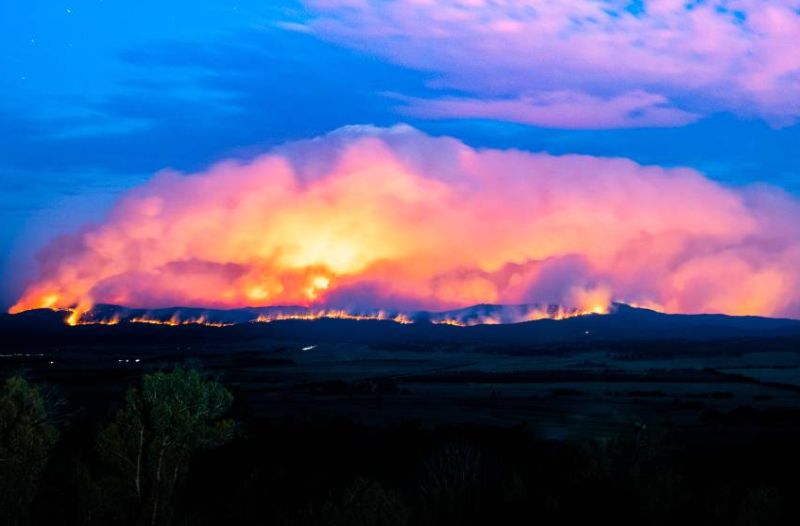
North Black range fires / Image: The Canberra Times
✦ On December 10, over 500 firefighters and emergency workers fought two out-of-control bushfires in East Gippsland.
Further Instances of Wildfire
✦ Following the extreme bushfire incidents, the schools were closed and worksite walk-offs were noticed in the neighboring areas around active fires.
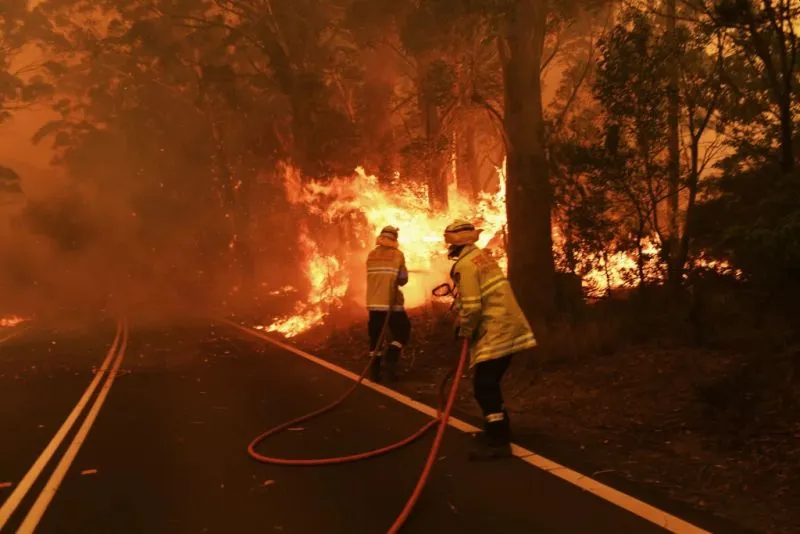
Firefighters combating an out-of-control wildfire in NSW / Image: The Sydney Morning Herald
✦ Unpredictable weather resulted in 30 new spot fires around the state after lightning strikes and heat records began to upsurge.
✦ December 17 was recorded as the hottest day ever, with a natural average temperature of 40.9 degrees recorded around the country. But, the next three consecutive days were officially the hottest days ever experienced in Australia.
✦ The hot air mass lingering over Australia shifted east with strong winds and made it difficult to control the fire. Most of southern NSW became immersed in flames.
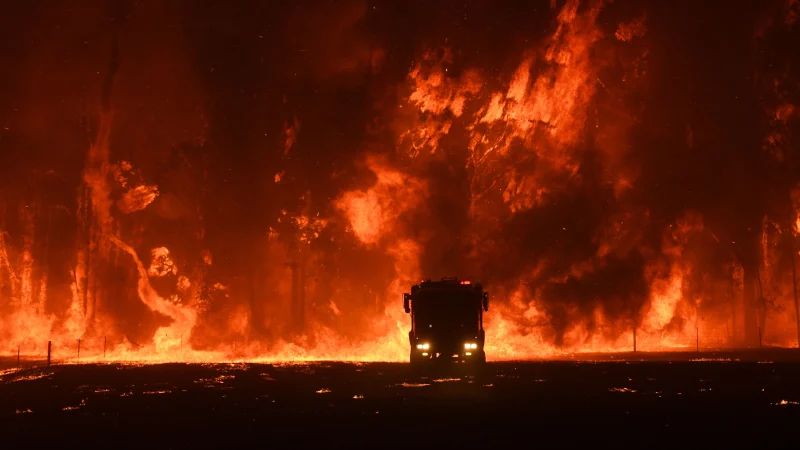
Rural Fire Service firefighters risking their lives to tackle the gigantic flames of fire / Image: The Sydney Morning Herald
✦ Sadly, two Rural Fire Service (RFS) firefighters – Geoffrey Keaton and Andrew O’Dwyer – lost their lives and three others were hospitalized when their truck rolled while fighting a bushfire in Buxton, south-west of Sydney.
Fiery End of 2019
✦ The wildfire in East Gippsland started to spread quickly. It had reached a size of 37,000 hectares and began to create its own weather, on December 21.
✦ This resulted in a smoke blanket covering Melbourne on December 23.
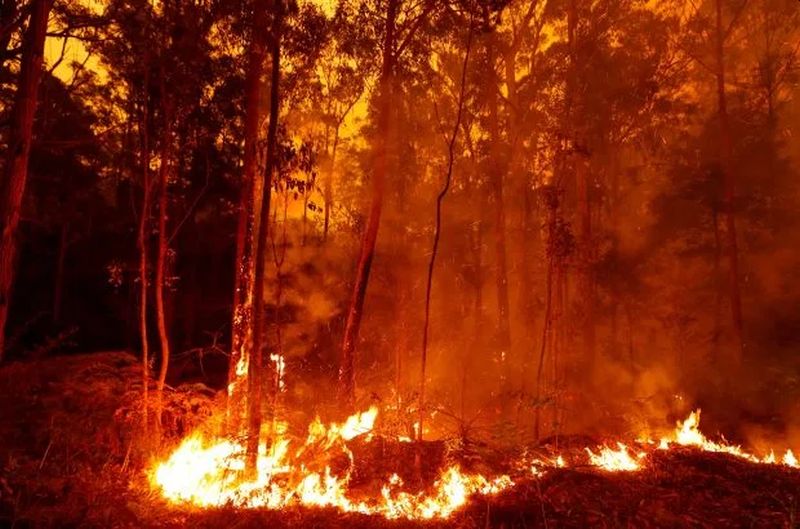
Raging fires burning through East Gippsland / Image: The Sun
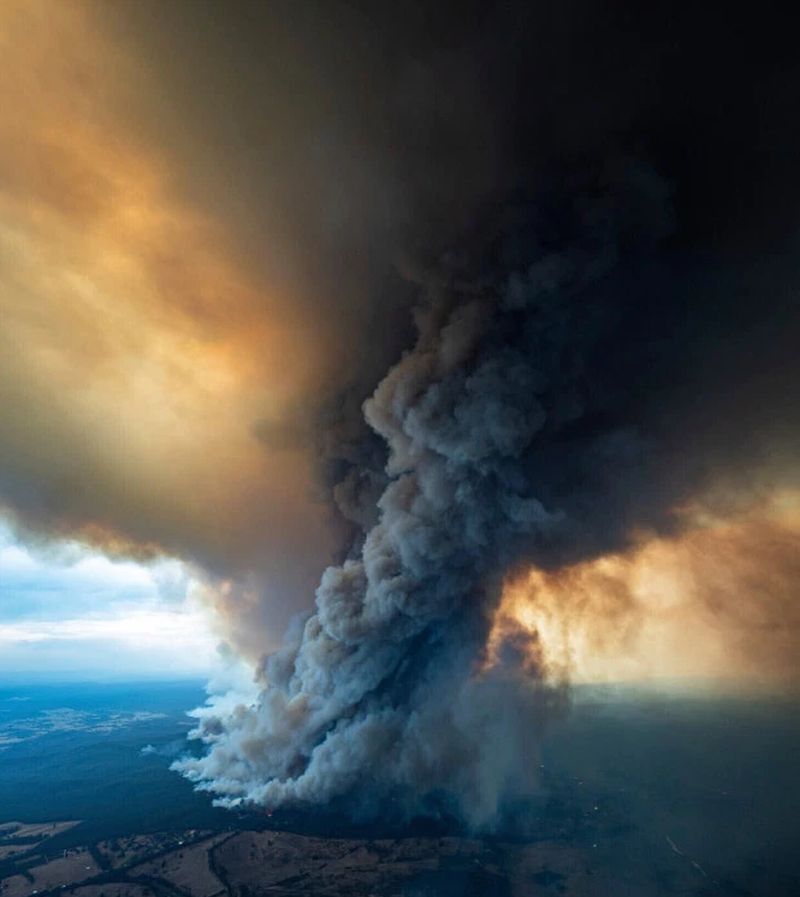
Thick plumes of smoke rising from the burning East Gippsland / Image: The Sun
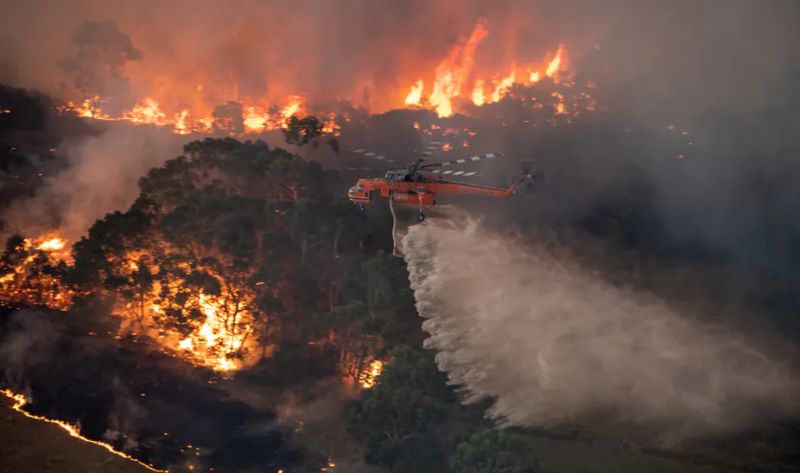
Waterbombers tackling a fire in Victoria’s East Gippsland region / Image: The Conversation
✦ The residents of NSW, who had taken shelter at the south coast spent Christmas away from home as hundreds of homes were destroyed in the raging wildfires.
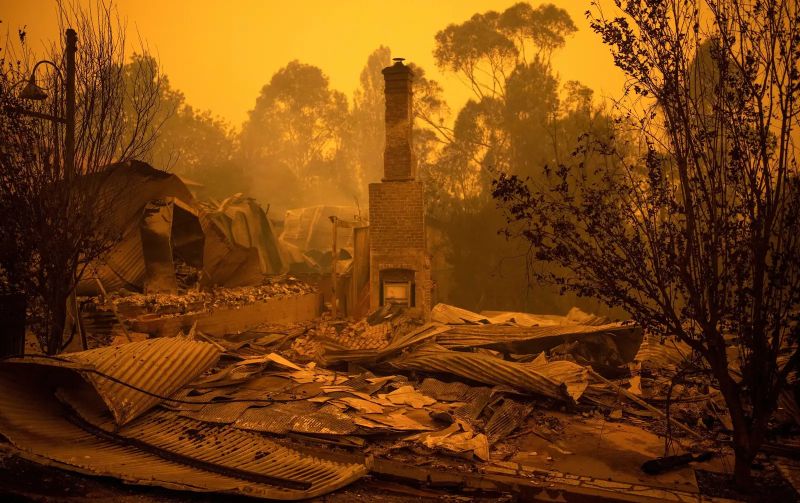
Wildfire destructed the residential areas in NSW / Image: Sean Davey
✦ Over 2,000 firefighters spent their Christmas in the field trying to save forests, homes, and most of all lives.
✦ After Christmas, the fire spread to the Baga Valley for the first time and quickly spread burning through the thick state forest area. Eventually, three fires joined the two others and the five blazes combined to become 260,000 hectares in size.
✦ The fire rapidly increased its range and burned down the Burrowa-Pine Mountain National Park.
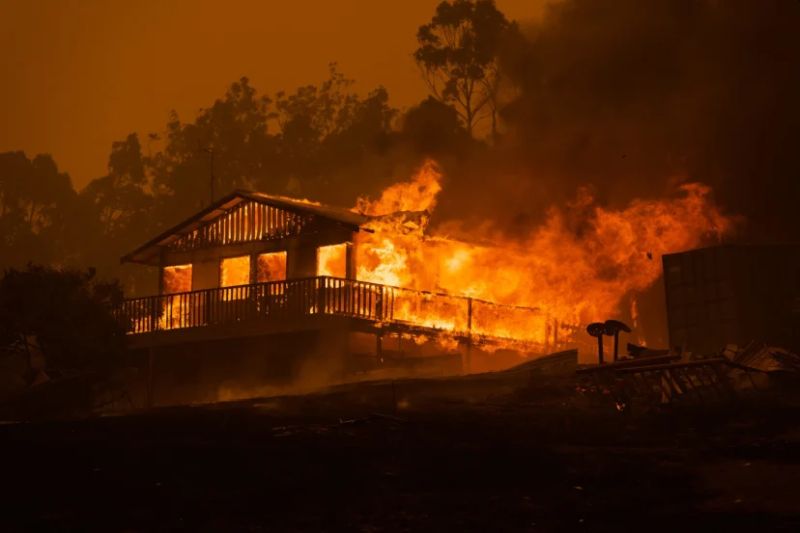
Mogo, a town on the NSW south coast has been devastated by bushfires / Image: The Sydney Morning Herald
✦ On December 30, more misfortune struck the fire department when Samuel McPaul’s vehicle rolled over near Jingellic. The cause behind the tragedy was an “extraordinary weather event” when a ‘fire tornado’ lifted a 10-12 ton RFS truck and flipped it upside down, claiming McPaul’s life.
Also Read: Raging Amazon Rainforest Fires – Why it Matters to Everyone on the Planet
✦ The New Year’s Eve didn’t bring any happiness or joy to the town of Mallacoota as the East Gippsland fires reached the size of 200,000 hectares and trapped thousands of people in the town. To survive the wrath of flames, the people started to evacuate the town and moved to the beach.
This is the situation in Mallacoota at the moment. A mother and her kids are sheltering in their boat on the water. People are reporting the sound of gas bottles exploding in town and quite a few homes have been burnt. @abcmelbourne #gippsnews #gippslandfires pic.twitter.com/XhS5SVvgqX
— Nicole Asher (@Nic_Asher) December 31, 2019
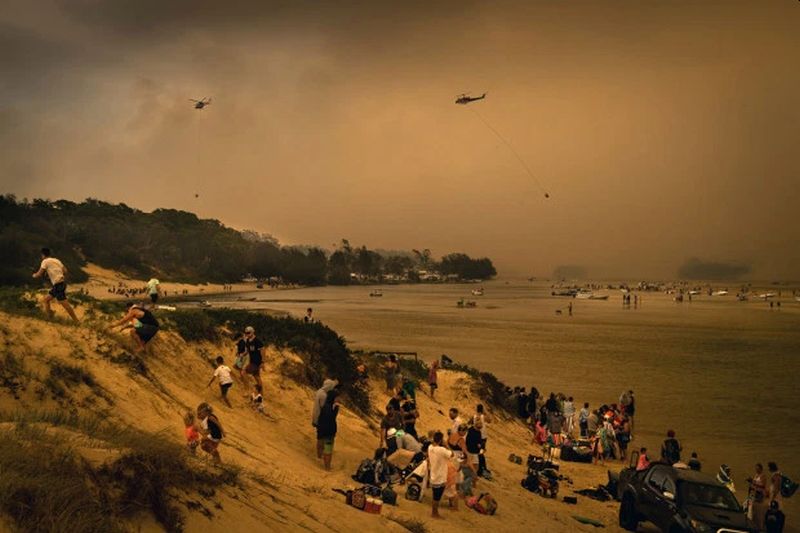
Thousands of people waited at Mallacoota beach to be evacuated / Image: The Sun
✦ Over 100 fires were spotted across New South Wales. These fires burned down 90 homes in Conjola Park, north of Ulladulla; 40 houses in Malua Bay, south of Batemans Bay; and 15 homes in Rosedale on the outskirts of Batemans Bay.
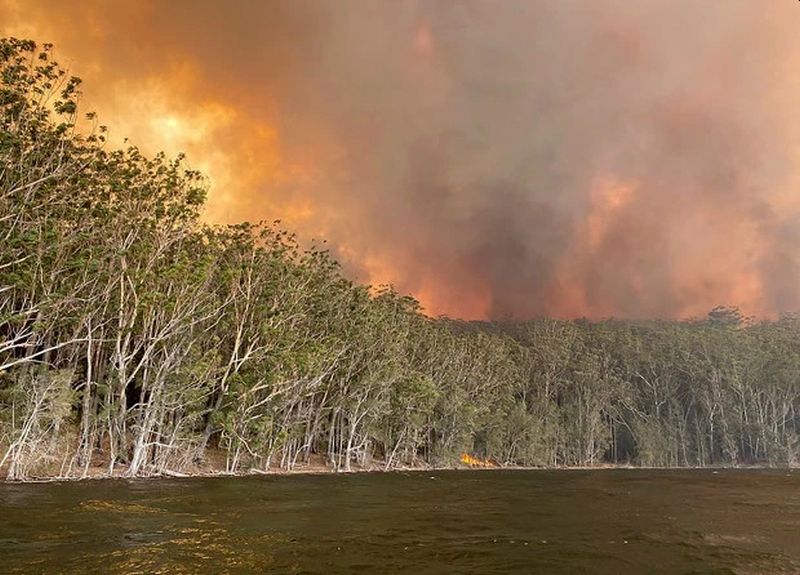
Fires at Lake Conjola / Image: The Sun
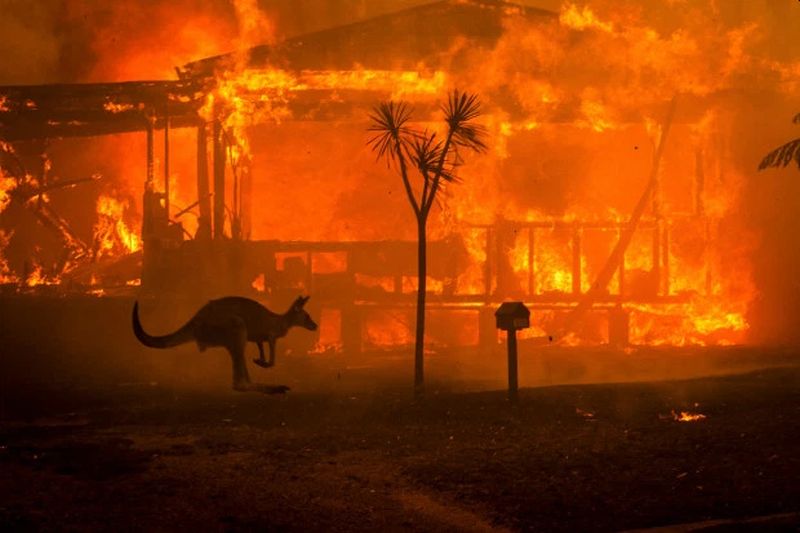
Kangaroo running past a burning house in Conjola, NSW, on New Year’s Eve / Image: The Sun
Burning Through January
✦ Thousands of people were stranded on the beach on New Year’s Day without power, internet, or road access. 15 evacuation centers were opened across the region.
✦ On January 2, an area stretching hundreds of kilometers from Nowra to the Victorian border and west to Kosciuszko were declared “leave zones” ahead of worsening conditions.
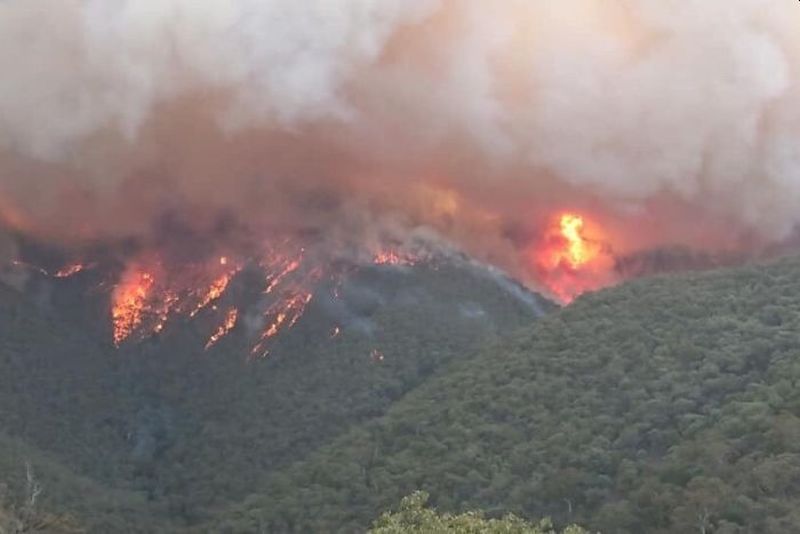
Fires in the state of Victoria that has burned 780,000 hectares / Image: ABC
✦ HMAS Choules rescued more than 1,000 people from Mallacoota. People were taken from the shores to the larger ships.
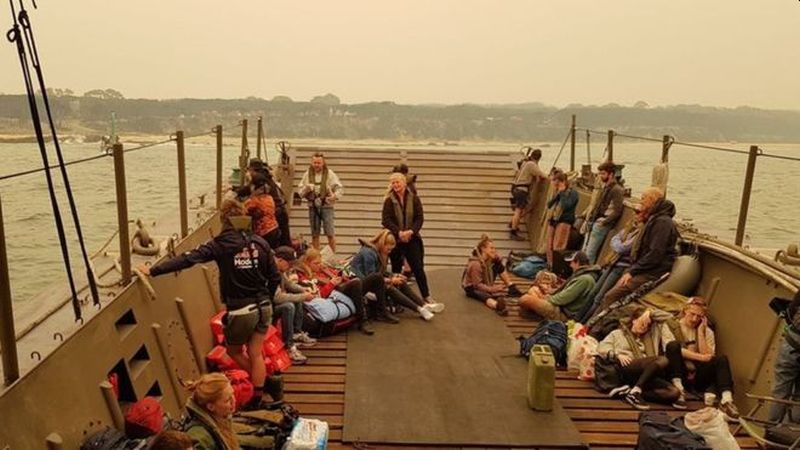
People were taken aboard HMAS Choules to safety / Image: BBC
✦ Many pine forests in the Snowy Mountains area were engulfed in fire on January 4. Given the circumstances, the town of Batlow was evacuated and others were put on high alert.
✦ Flames burned down the old hospital in southern NSW Town and later blew up the petrol station, burnt houses and an unaccounted number of outlying properties.
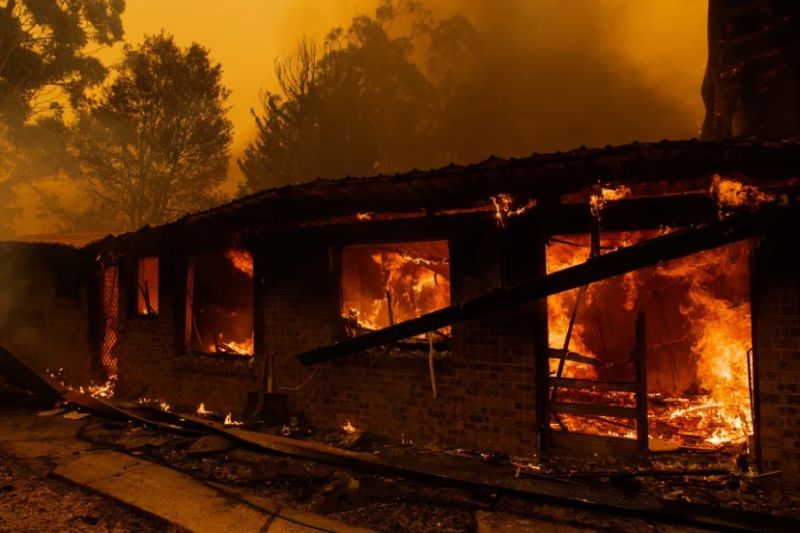
Tomakin in NSW has been destroyed by the bushfires / Image: The Sydney Morning Herald
✦ 3,000 army reservists were called to work with communities in NSW, Victoria, South Australia, and Tasmania.
✦ The fire crawled through the Snowy Mountains and spread toward the south, which is feared to merge with Victoria’s massive Corryong fire in the state’s northeast.
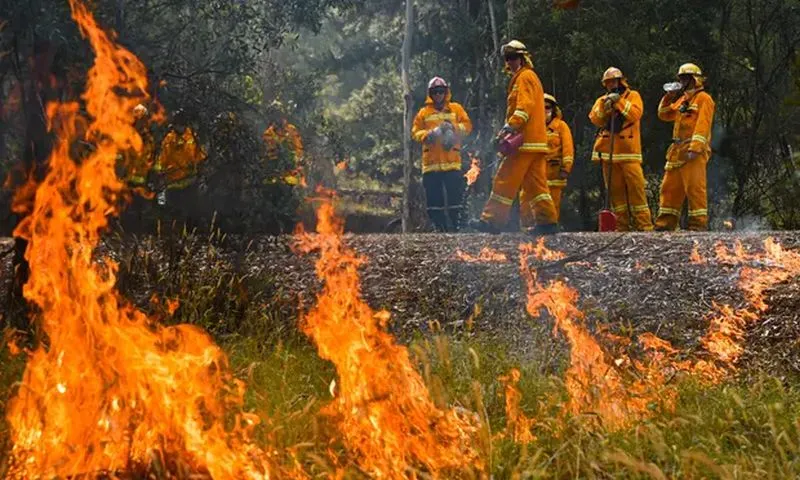
Firefighters at a fire in Corryong / Image: The Guardian
Death and Destruction Follows
The raging wildfires have brought massive death and destruction with them. Over 29 people have lost their lives, the number of dead animals is estimated to have reached a billion and thousands of animals have endured injuries in the wildfire that has also destroyed an unaccounted number of forests and outlying properties.
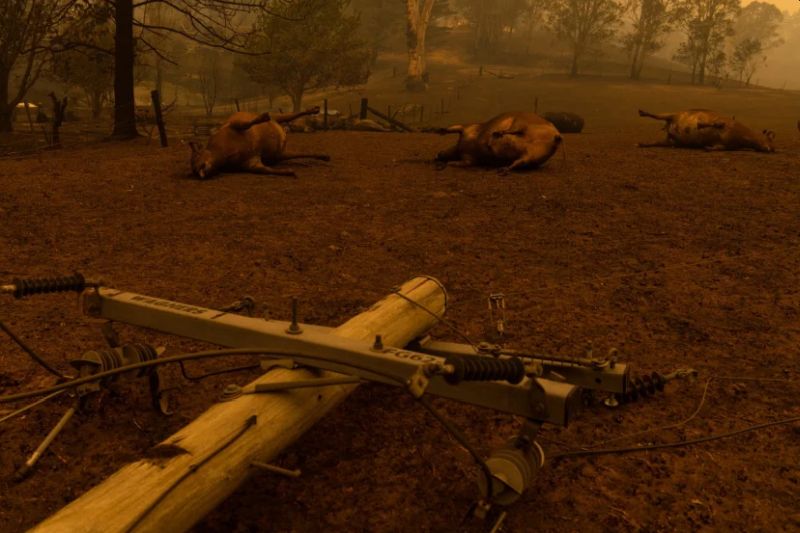
Dead livestock on a property southwest of Cobargo / Image: The Sydney Morning Herald
On Kangaroo Island, which is considered the biggest and safest habitat for kangaroos and koalas, the fires have burned through 160,000 hectares, killing thousands of animals of various endangered species.
Kangaroo Island Then and Now ? #PrayForAustralia pic.twitter.com/lTYf5cHDEk
— ԁ૯νіה (@90sWizard) January 7, 2020
The rising temperature and variable winds are making it very difficult to control the wildfire. The western side of the island is still ablaze, destroying the biodiversity-rich area.
A shocking video of dead animals strewn across a roadside in New South Wales killed in the #AustralianBushfire .
At least 480 million mammals, birds and reptiles are likely to have died in the state alone since September. Devastating.
Credit: The ‘new’ Batlow Hotel pic.twitter.com/BaGFsMvfm6
— Patrick Greenfield (@pgreenfielduk) January 5, 2020
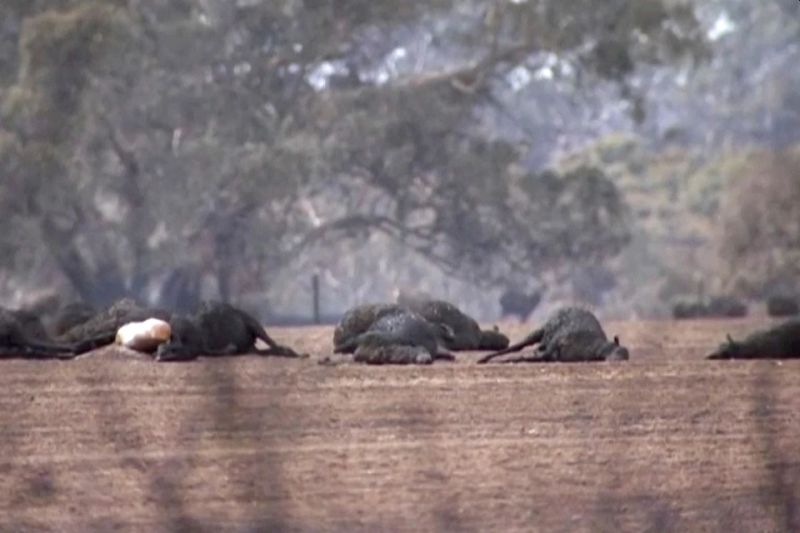
Charred carcasses of wild animals lay around after the bushfires / Image: The Sun
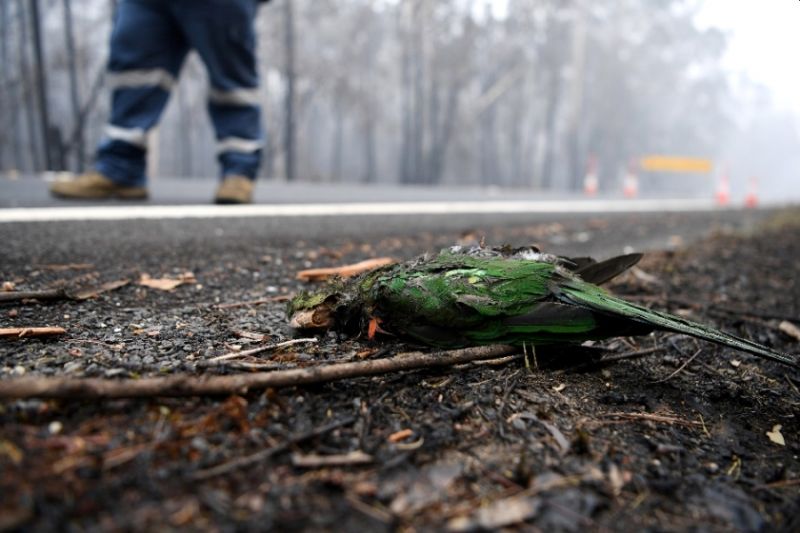
A dead Australian native bird is seen on ashes on the ground near Eden, Australia January 7, 2020.
Photo by: REUTERS/Tracey Nearmy
The western half of the island was home to about 25,000 koala bears and very few have survived through the bushfires.
The fire department and many other volunteers have been rescuing the wild animals and nursing them back to health.
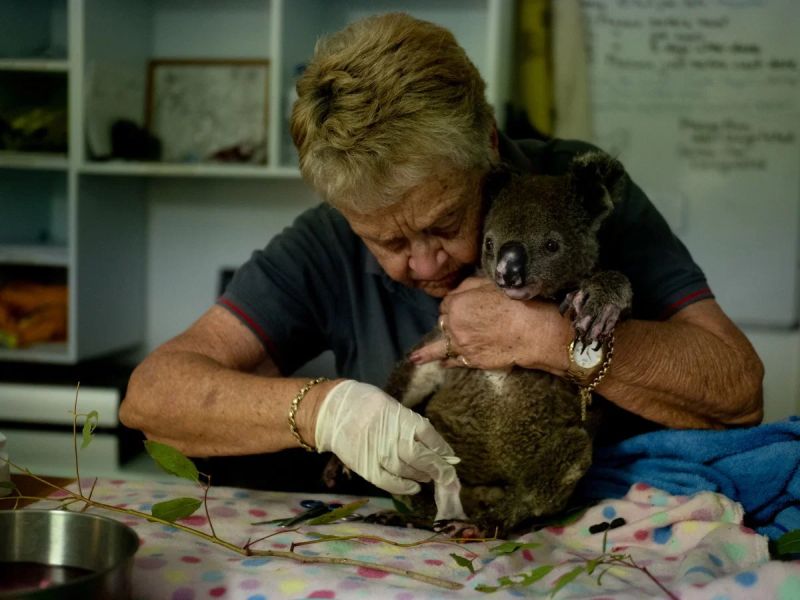
Volunteer tending to bushfire survivors in Port Macquarie Koala Hospital / Image: Time
Despite the arrival of rain on January 9, the bushfires still continue to rage on. New South Wales remain under a state of emergency, while the fires are also threatening parts of Victoria and Australia Capital Territory.
Meanwhile, the people are furious at the Australian Prime Minister Scott Morrison for not providing them enough resources to battle this catastrophic event and for his careless attitude on the climate crisis. Earlier he went for a family vacation in Hawaii during the continued incidents of bushfires in Australia.
During his visit to bushfire victims, the people were hostile and unfriendly toward Morrison. The victims accused him of being careless and demanded that more funds should be provided to Rural Fire Service so they could efficiently control the wildfire.
Donations and Relief Funds
People across the world are making donations and raising funds to help the victims of bushfires in Australia. The Australian Red Cross is accepting the contributions towards its Disaster Relief and Recovery Fund, which has so-far deployed 1,285 staff and volunteers to disaster-affected communities.
Volunteer organization BlazeAid is accepting donations to help rural families rebuild after the damaging bushfires in Australia. The Port Macquarie Koala Hospital, which helps rescue and treat injured koalas, is accepting online donations. A separate GoFundMe campaign has raised more than $4.7 million for the organization.
Celebrities who’ve lent a helping hand
✦ Formula One world champion Lewis Hamilton has donated more than 500,000 Australian dollars to support fire and animal rescue services working in the Australian bushfire crisis.
✦ Elton John, the Marvel star Chris Hemsworth and the heavy metal act Metallica are the latest big names to donate significant amounts to the Australian bushfire relief effort, with John and Hemsworth each committing A$1m (£523,000) to the cause.
✦ Earth Alliance, a new organization co-chaired by actor Leonardo DiCaprio, announced to donate $3 million bushfire fund, which will be directed to assist the firefighters, help the local communities, and save wildlife.
✦ A pledge of $48 million was made from Australian mining billionaire Andrew Forrest’s Minderoo Foundation.
✦ The Australian comedian Celeste Barber has helped with over $20m in donation and likewise celebrities Pink, Nicole Kidman made considerable donations to help the New South Wales Rural Fire Service fight the devastating bushfires around the state.
✦ Facebook announced its own ~$170,000 donation to the Australian Red Cross. The social media giant will also match up to $700,000 in donations made to GlobalGiving’s Australian Wildfire Relief Fund.
✦ The government commits $2 billion to the national bushfire recovery fund. Insurance claims surpass $700 million.
✦ The donation will go to WIRES Wildlife Rescue, WWF Australia and the Rural Fire Service.
✦ On January 22, 2020, Formula 1 announced that it is to hold an auction of valuable memorabilia and experiences to raise money to help those affected by the Australian bushfires.
The world has come forward to help Australia amidst the fiery crisis. Though the donations and funds might bring temporary relief and recovery aids to the victims (humans and animals alike), the crisis is not over yet.
Despite the showers of rain that brought a sigh of relief, the fires are predicted to increase. People are praying for Australia and lending a helping hand from all over the world.
The plumes of smoke are not only hovering over neighboring New Zealand but have also reached the western continents. The environmentalists are worried that the continued emissions through the bushfires are contributing in a major way to global warming. Effectively it is affecting the whole world.
Survival and Recovery
Meanwhile, the New South Wales government is dropping vegetables from the sky for survival and recovery of the starving animals in the critical time when the fires have burnt down all-natural food sources. The officials have dropped down 2,000 pounds of sweet potato and carrots across the different colonies in the past week.
Operation Rock Wallaby ?- #NPWS staff today dropped thousands of kgs of food (Mostly sweet potato and carrots) for our Brush-tailed Rock-wallaby colonies across NSW ?? #bushfires pic.twitter.com/ZBN0MSLZei
— Matt Kean MP (@Matt_KeanMP) January 11, 2020
The fresh green shoots sprouting from the trees after the devastation by bushfires have shone a ray of hope for the masses. Many of the plant species in Australia have experienced fires for tens of millions of years. The flora of the country has modified itself to survive during the wildfires through re-sprouting and regeneration.
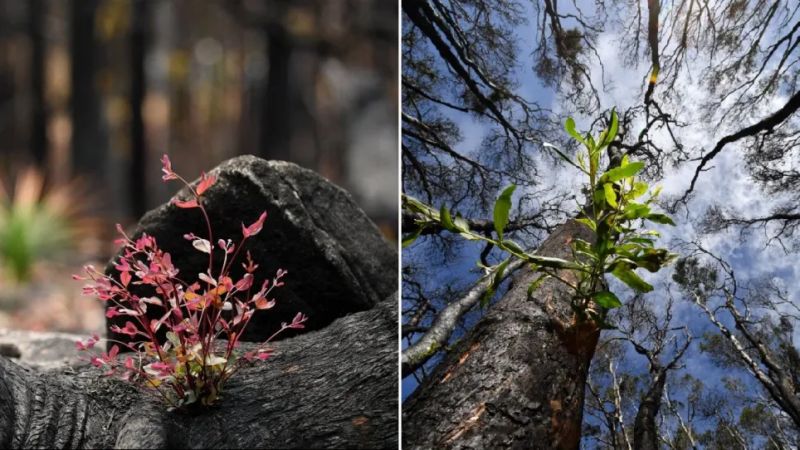
New sprout shooting from trees in the wildfire damaged areas / Image: AAP
In the meantime, a search dog named Taylor has been finding injured koalas during the bushfire crisis. The 4-year-old English springer spaniel ventures into burnt-out bushland and sniffs out the scent of fur of koalas or their faeces. Several of the koalas found by Taylor have been treated at Port Macquarie’s Koala Hospital.
Taylor has been focused on finding injured koalas since she was just a few months old and now has become an expert in the job. The trainer Ryan Tate, who runs the Tate Animal Training Enterprises that specializes in detector dog services, says that when told “Koala, Find!”, Taylor starts running around sniffing out the animal and each time she finds a koala, she is rewarded with a tennis ball or culinary treat.
While recent rains have offered limited hope in some areas, there is not likely to be a much greater respite in the next two months. Although the rains brought brief relief to the people, it is unpredictable if the rains will pacify the ferocity of the raging wildfires.
Rain Adding to the Woes
Where the rains have brought some relief from the fires, it has also contaminated the waterways by washing ash and sludge from bushfires into the Macleay River in New South Wales. The washed away ash has suffocated aquatic life and the riverbed stinks of rotting vegetation and dead fish. The reported dead fish species include Australian bass, eels, bullhead mullet, yellow-eye mullet, herring, gudgeons, and catfish.
The locals say that the rain in the past few days has seen more ash and mud from the parched and burned landscapes running into the river. Rainfall events are adding ash from the extensive bushfires throughout the region into local catchments, as well as other organic matter and sediment. This can cause rapid drops to oxygen levels in the water.
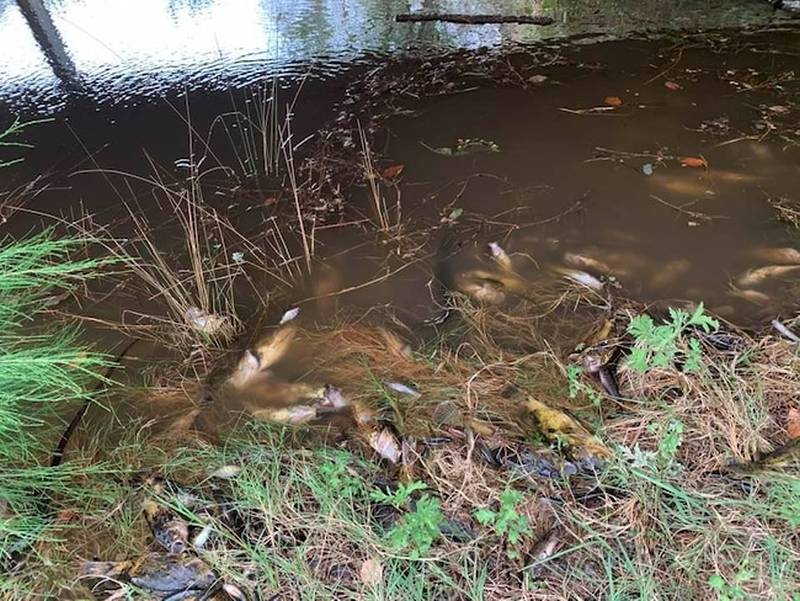
Dead fish in the waterways of Macleay River, New South Wales / Image: Larry Newberry/7 News
The bushfires in 1939 had caused the ash from bushland to run into Lachlan River and the fish population never recovered. It will take a long time to restore the river’s health back to normal and it is likely to deeply affect the marine population depending on the river.
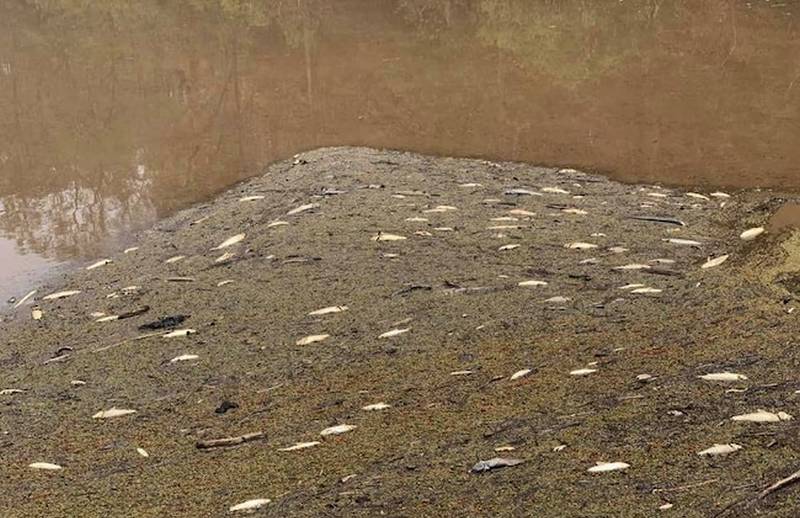
Rain has contaminated the water bodies with toxic ash / Image: Larry Newberry/7 News
The recent session of rain and thunderstorms have dumped much-needed rains on bushfires but may have caused other problems. The ash and sludge from the bushland are likely to contaminate most of the catchments in eastern Australia. 80 fires out of 130 have satiated and the remaining will soon be under control. Sydney had its wettest day in four months.
Roads are blocked, paddocks are lakes and dams are full! #NSW #rain #boggabri #gunnedah @abcnews pic.twitter.com/KBkIAqzw6X
— Dale Drinkwater (@DaleDrinkwater) January 16, 2020
Australian Reptile Park in Somersby, New South Wales, was flooded as heavy rains hit the region on January 17.
Thunderstorms and heavy rains are likely to bucket down in Australia’s east coast on January 18. The states of Victoria, NSW, and Queensland were badly hit by wildfires, killed 29 people, burnt down 2500 homes, and scorched millions of acres of land.
Parts of Queensland’s south saw triple the monthly rainfall overnight. Farmers in NSW and southern Queensland rejoice as the severe spell of drought broke after the creeks flowed again. More rainfall has been predicted to cool down the heat in eastern Australia in the coming days.
Rain and storms have provided useful falls over much of east #NSW in the past few days. Further rain will fall in the east of the state, especially the north east until Sunday. On Monday falls will shift to be heaviest in the south east. NSW forecast: https://t.co/YYPYaRT8Sc pic.twitter.com/6psr0tZPi8
— Bureau of Meteorology, New South Wales (@BOM_NSW) January 17, 2020
To the relief of people, the Bureau of Meteorology had predicted heavy rains on January 19 and 20, but the following events were not pretty. Later, the meteorological department issued a series of severe thunderstorm warnings on Sunday evening for inland NSW with the associated winds generating massive dust clouds.
Nyngan‘s Grace Behsman took this video of a huge dust storm rolling in as they approached town. Watch til end – scary moment when the storm overtakes and everything goes black. The dust storm has swept the west & is encroaching Dubbo. Remember: not everyone’s celebrating rain ? pic.twitter.com/5VMLrFbrrT
— Lucy Thackray (@LucyThack) January 19, 2020
The thunderstorms produced damaging winds across central NSW that whipped up dust storms turning the daytime as dark as night in some towns. A gust of 94 km/hour at Parkes about 6:30 pm and 107 km/hour at Dubbo about 7:45 pm created a massive wall of dust storms.
When the bureau forecasts rain and this arrives… AGAIN! #fudust #sickofcleaning #whenwillwegetrain pic.twitter.com/NHQKkVT7gy
— Jen Browning (@jen_browning) January 19, 2020
Rain and hail also wreaked havoc in Victoria, sparking almost 1500 calls for assistance with more severe weather on the way as wildfires continue. The State Emergency Service received 1453 calls for assistance since Sunday morning, more than 1000 of them for building damage.
Parts of NSW were hit by hail the size of tennis balls and destructive, damaging winds as three major storm cells hit populated areas on Monday afternoon. The Parliament House in Canberra also received destructive hailstorm.
Parliament House at 12.59pm, captured by our Auspic photographer David Foote. pic.twitter.com/TmUQtXLtM4
— Australian Parliament House (@Aust_Parliament) January 20, 2020
A few parts of Queensland are likely to bear the brunt of wild weather after it was flooded with heavy downpour over the weekend. The Bureau of Meteorology has warned the people to stay indoors as the weather is likely to worsen in the coming hours with flash flooding.
This is movieworld and the exit to Dreamworld ?? FIRES AND FLOODS WOW
The fact that my job is only closed 2 times a year for ANZAC and Christmas, it takes a lot for themeparks to close down for the day pic.twitter.com/Gsp6Jjbwjg— ? T O N I ? (@Nesiian_) January 17, 2020
More photos of car damage in #CanberraStorm — golf ball size #hail in the middle of summer. #Australia #hailstorm pic.twitter.com/CX95E59VDl
— Eric Byler (@ericbyler) January 20, 2020
The @BOM_NSW are tracking a number of large and dangerous storm cells across NSW. These storms are likely to produce damaging, locally destructive winds, large and possibly giant hailstones and heavy rainfall.
For assistance in storms, contact the @NSWSES on 132 500. #nswrfs pic.twitter.com/pGpTqaT02C— NSW RFS (@NSWRFS) January 20, 2020
The Crisis Continues
On January 22, a massive wildfire approaching the Canberra airport prompted a call for residents to take shelter in their homes while the firefighters remained at the scene. The residents of three Canberra suburbs were told it was too late to evacuate as the out-of-control fire approached Beard, Oaks Estate and West Queanbeyan. The 90-hectare blaze burning out-of-control south of Canberra airport was upgraded to the ’emergency level’.
Please be advised, no flights have been affected. Please allow additional time to get to the airport and keep an eye on @ACTPol_Traffic for traffic updates. https://t.co/wfhtwI87lN
— Canberra Airport (@CanberraAirport) January 22, 2020
The fire department has suffered another loss, when the water-bombing C-130 plane crashed on January 23 and killed three firefighters on board. RFS Commissioner Shane Fitzsimmons has confirmed that three firefighters who have died in the downed C-130 were US residents. Meanwhile, the fire has grown to 425 hectares in size.
Soaring temperatures and strong winds reignited bushfires in Australia’s southeast cloaking Canberra in hazardous smoke and forcing the airport to close, after a few days of cooler weather brought some relief. Over 90 blazes continue to rage across Sydney and in Victoria 17 wildfires are still burning.
On January 28, as the respite of rains was wearing off slowly, a total of 59 bush and grass fires were burning across the state of New South Wales, out of which 28 were out-of-control. More than 1,300 firefighters were using the favorable conditions to contain the wildfires.
The department of meteorology has predicted the heat waves are likely to hit the area in the coming as the rains will slow down. While the Australian Open tennis tournament is coming up, the temperatures in Melbourne are predicted to spike up to 41 degrees Celsius.
The Fire Emergency
In the latter half of January, the heavy rains brought a momentary relief to the burning Australia. But, as the rains receded, the temperature started to spike up and strong winds fueled the wildfires even more.
There are over sixty active fires in NSW, one at emergency level; 27 in Victoria, of which three are at emergency level. Temperatures in Canberra and southern states of Tasmania and Victoria have reached over 40 degrees Celsius.
The Australian capital region is under a state of emergency as authorities are afraid of severe fire danger in densely inhabited areas toward the beginning of February. The threat is posed by a blaze on Canberra’s southern fringe that has razed more than 21,500 hectares (53,000 acres).
It is the first fire emergency for the ACT area since 2003 when wildfires killed four people and destroyed almost 500 homes in a single day.
#CanberraFires the fire is edging slowly closer, @ Gordon Pond 31.01.20 pic.twitter.com/E2sbWolPLE
— Lea Hall (@RissaHall) January 31, 2020
Narrow Escape
On January 31, a fire emergency had been declared in Canberra – the first in the area since the deadly fires in 2003. However, the capital city narrowly escaped the wrath of ravaging wildfires while the people remained at alert. The blazes did not enter the southern suburbs as it was feared.
Meanwhile in NSW, 63 bushfires were still active on February 1, with 25 of them out-of-control .
At 6am, 63 bush and grass fires are burning in NSW, 25 still to be contained. 3 fires remain at the Watch and Act alert level. Crews have worked tirelessly overnight to protect homes and slow the spread of fire, which they will continue to do today with favourable weather #nswrfs pic.twitter.com/ryWqA1EygX
— NSW RFS (@NSWRFS) February 1, 2020
On February 6, heavy rainfall brought reprieve to the bushfire hit areas. The Bureau of Meteorology issued severe thunderstorm warnings for the southeast Queensland state, while parts of NSW state were submerged in flash floods caused by the heavy rainfall that is expected to continue for several days. Heavy rains and a tropical cyclone forecast to hit country’s northwest toward the end of first half of February.
On February 7, most of Australia’s wildfire hit east coast was drenched by the biggest rainfall in almost 20 years. The rainfalls have satiated some of the most dangerous blazes, providing a relief to farmers battling the extended drought.
Not sure Wakehurst Parkway should still be open? #sydneyrain pic.twitter.com/9my5SHpp09
— Stephen Spencer (@sspencer_63) February 7, 2020
The rains have put out 20 of about 60 fires within a day in NSW, while Victoria still had 21 active wildfires.
So nice listening to rain falling last night & driving with windscreen wipers on for a change this morning. @BOM_NSW indicates continued rain this next week & importantly, falls across our fire areas which will be so welcomed by our farmers, fire fighters & all affected. #NSWRFS pic.twitter.com/gJ3aFRQlzF
— Shane Fitzsimmons (@RFSCommissioner) February 6, 2020
The rains might have brought relief to the current situation, which still is somewhat out-of-control in some parts of the country, the forecast for tropical cyclone, thunderstorm, and continued rainfall is unnerving as it could further worsen the situation.
While the rains continued, many regions got heavily flooded. The deluge has also extinguished 30 fires, leaving only four “uncontained”. Since February 7, Australia’s largest city, Sydney, has received 391.6mm of rain – the equivalent of a four month total.
The consistent rains caused troubles for the people; emergency response services in NSW said that they had received about 10,000 calls across the state on February 10, as wild weather brought down trees, flooded and disrupted public transport.
Rain has significantly assisted reducing the fire activity across areas of NSW. It is a welcome relief for communities and firefighters alike. 26 bush and grass fires are still burning across the state with 4 not yet contained (Snowy Valley and Monaro areas). #nswrfs #nswfires pic.twitter.com/w3aUaPsuZw
— NSW RFS (@NSWRFS) February 10, 2020
Mactier street underwater at Narrabeen. Someone took the gamble and lost #sydneystorm #narrabeen #narrabeenlake pic.twitter.com/ITfGKoeEzB
— Angelina (@angesoutham) February 9, 2020
Not only the human population, but the wildlife is also deeply affected by these recurring wildfire incidents. Officials estimate the fires have ravaged more than 80% of the unique ecosystems of at least 49 animal and plant species already listed as ‘threatened’.
Meanwhile, the recent government analysis of the severity of the damage done by bushfires, which were burning since last September, shows that around 113 wildlife species need urgent attention after this crisis. The Kangaroo Island dunnart, the northern corroboree frog and Blue Mountains water skink are among the species in dire need of attention.
19 mammals, 13 birds, 20 reptiles, five invertebrates, 22 crayfish, and 17 other fish species have been identified as the animals that require assistance in coming weeks and months. The list comes after the environment minister, Sussan Ley, convened an expert panel to analyse which species required short-term assistance and long-term recovery work in the coming weeks and months.
If the fires are not controlled and eliminated soon, it could drastically change the complexion of the land down under.
